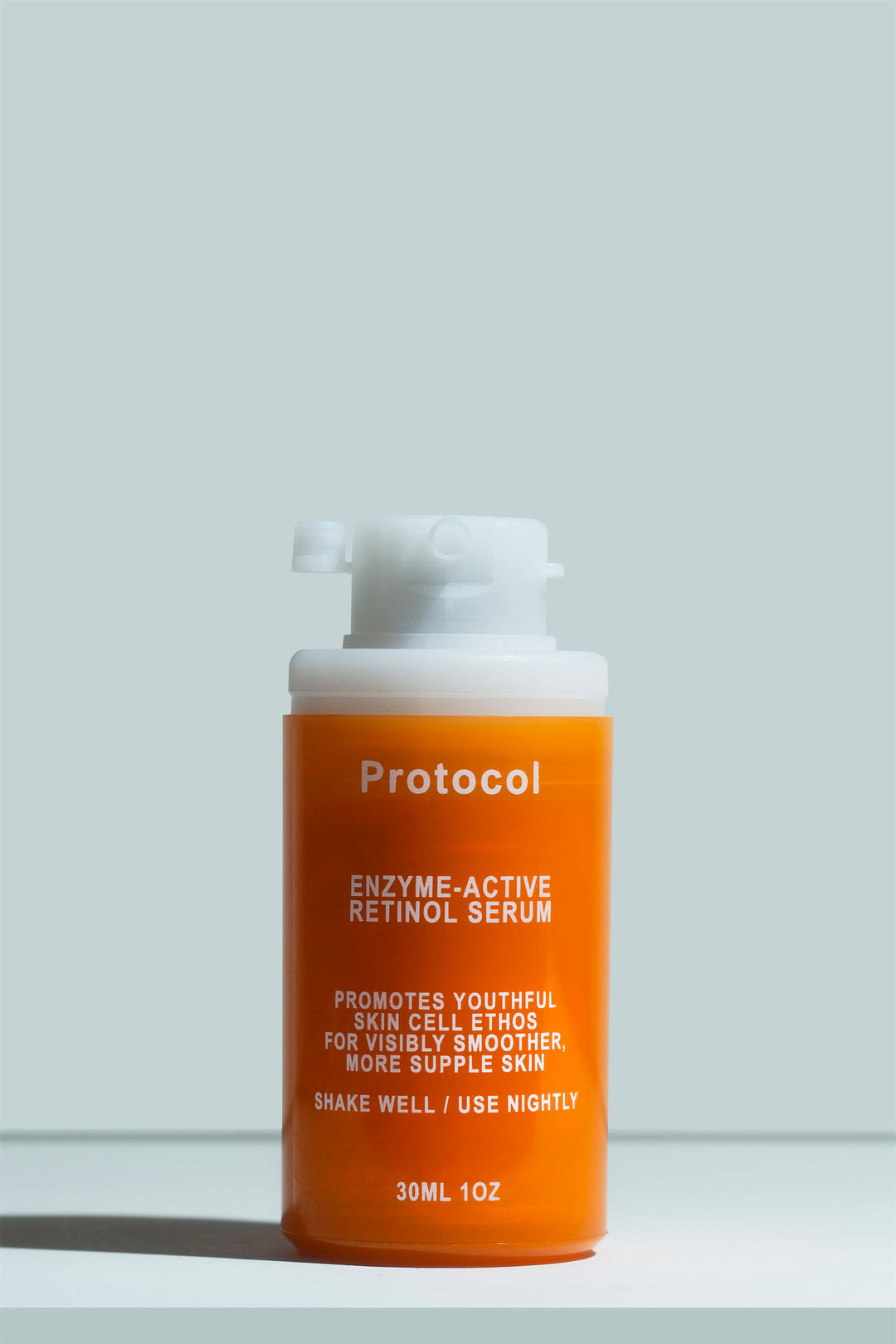High Molecular Weight Hyaluronic Acid: Why It Matters

You’ve probably heard about the importance of the molecular weight of hyaluronic acid. Most brands highlight that they’re keeping it low, while others (like us) prefer high molecular weight hyaluronic acid. But what is molecular weight, exactly? And why does it matter so much when it comes to hyaluronic acid?
In this post, we’ll explain the concept of molecular weight in skincare. We’ll go over the differences between the weights of our favorite super-humectant, and explain why at Protocol, we decided to go high.
What is hyaluronic acid: a quick refresher
Before we get into the nitty-gritty, here’s a quick refresher on hyaluronic acid (often shortened to HA). It’s the hottest hydrating agent in skincare right now. It belongs to a category of ingredients called humectants, substances that absorb and hold onto water like microscopic sponges. It occurs naturally in the human body, but as with many other substances, it slowly depletes as we get older.
Once absorbed by the skin, hyaluronic acid attracts water to the layer where it is situated, creating a more plump and hydrated appearance. Better hydration correlates with healthier-looking skin: Fine lines and wrinkles look softer, and the skin looks overall smoother, tighter, and dewier.
Many other amazing humectants in skincare don’t generate as much hype, like glycerin, panthenol, and sodium lactate. What makes HA special is that it can hold more water than other humectants, so it’s potent even at small percentages.
Benefits of high molecular weight hyaluronic acid
Most of the benefits of using hyaluronic acid come from its action as a humectant. That said, as a good humectant, there’s a lot it can improve:
- Hydration: Hyaluronic acid holds significantly more water than it weighs, and helps keep it in the skin.
- Potent: A little HA goes a long way, which is why it’s only used in small percentages in most products.
- Smoothing: Hydrated skin is often smoother and softer to the touch.
- Soothing: Hyaluronic acid is also associated with soothing and barrier-boosting effects that help those with sensitive skin.
- Anti-aging: By loading the skin with moisture, HA plumps it up significantly, which helps to minimize the appearance of fine lines.
- Glow: Hydrated skin looks more reflective, dewy, and glowy, which is often associated with smoothness and health.
- Biocompatibility: Hyaluronic acid occurs naturally in the skin’s extracellular matrix, so even when applied topically, it has a good affinity with the skin.
Why molecular weight matters
With all skincare ingredients, the weight of the individual molecules plays a big role in how the molecule will penetrate through the skin, or if it will penetrate at all. Molecular weight is measured with a unit called the dalton.
Most skincare products are formulated to impact the stratum corneum, which is the outermost layer of the skin and is largely comprised of anucleated skin cells (i.e., largely inactive cells with limited biological activity but important protective effect.).
For an ingredient to penetrate beyond the stratum corneum into the lower layers of the epidermis, it needs to have a lower molecular weight.
Normally, we want our skincare actives to have a lower molecular weight, because we want them to impact the lower levels of skin. Retinal, the skin-transforming powerhouse in our Enzyme-Active Retinol Serum, has a molecular weight of approximately 284 daltons, while ascorbic acid has a molecular weight of around 176 daltons.
However, in the case of certain ingredients, the molecular weight directly corresponds with irritation. For example, sodium lauryl sulfate with its 288 daltons is a major potential irritant. It’s almost exclusively used in cleansers, where the risk is mitigated by washing it off. Even so, it’s becoming less popular and many brands choose to leave it out of their formulas.
High vs low molecular weight hyaluronic acid
So how do high vs low molecular weight hyaluronic acid compare? And what about mixed-HA formulas? Here are the key differences.
The molecular weight in numbers
Depending on how it’s produced and manipulated, the molecular weight of hyaluronic acid can vary very widely, as can its penetration:
- Low molecular weight HA has between 20-300 kilodaltons
- Medium weight is between 300-1000 kilodaltons
- High weight has between 1000-1400 kilodaltons
Penetration
Low molecular weight hyaluronic acid has become more popular in recent years because of its greater depth of absorption. Research shows that low molecular weight HA can penetrate down to the bottom of the epidermis.
By comparison, medium-weight HA penetrates only to the center of the epidermis, while high molecular-weight HA only permeates the stratum corneum, which is the outermost layer composed exclusively of dead cells.
Many believe that low molecular weight hyaluronic acid is better because it can penetrate more deeply. After all, isn’t it better to have more hyaluronic acid throughout the epidermis?
In reality, the level of skin most impacted by dryness and dehydration is the stratum corneum. It’s our body’s last little layer of defense against the outside world, and it’s also the last level of skin to receive any moisture or nutrients from the body. When it’s dry and dehydrated, it can crack or become rough. This makes the skin feel uncomfortable and can potentially allow for bad pathogens to penetrate through and damage the skin.
Risk of irritation
As a rule, the more deeply an ingredient can penetrate past the stratum corneum, the more likely it is to induce irritation. And indeed, low molecular weight hyaluronic acid has been found to have a pro-inflammatory effect.
Our body produces hyaluronic acid as part of the wound-healing process, setting off the inflammatory cascade that ultimately leads to healing. However, in healthy skin, some users may experience irritation.
It seems that irritation is likeliest when using several products with hyaluronic acid within one routine, especially with low or mixed molecular weight hyaluronic acid formulas. This effect hasn’t been documented in medical or scientific literature yet, but within the skincare community, there have been a lot of incidences reported by enthusiasts, influencers, and even dermatologists.
High molecular weight hyaluronic acid has an anti-inflammatory effect, by contrast. While this effect hasn’t been measured topically in human skin, we suspect that high molecular weight HA is significantly less likely to irritate, even with consistent use.
Anecdotes aren’t data, but at least within our lab team, those with sensitive skin have not had any issues using our Hyaluronic Acid & Niacinamide Hydration Cream over long periods.
How to hydrate the skin, then?
If deeply penetrating low molecular weight hyaluronic acid may pose a risk, then how can you effectively hydrate your skin’s lower levels? The best way is to use water itself. The molecular weight of H2O is very low, so with prolonged saturation like in the bath or shower, your skin will absorb a ton of it. The trouble is that the water starts to evaporate pretty soon after it finds its way in.
That’s where occlusives come in - occlusives are water-repelling ingredients that don’t allow evaporation. If you’re experiencing noticeable signs of skin dehydration, get in the habit of slathering on a rich, occlusive product immediately after every shower.
At Protocol, we developed Water Lock for this purpose. It’s a silky, non-greasy balm with a powerful occlusive formula and just a bit of high molecular weight hyaluronic acid. It creates a seal over the skin that prevents water evaporation while keeping the surface looking smooth and hydrated.
Another way to combat dehydration is to take a long-term approach. In our Hydration Cream, for instance, we combined hyaluronic acid with niacinamide. Niacinamide has a low molecular mass, but it’s not a humectant. Instead, niacinamide plays a role in improving the skin’s natural ability to retain moisture from below while also combatting irritation, signs of aging, and discoloration.
When they go low, we go for high molecular weight hyaluronic acid
The science isn’t conclusive, but we believe that high molecular weight hyaluronic acid is the safer option, especially with regular use. It doesn’t penetrate as deeply as its low molecular weight counterpart, but for those with sensitive skin, it’s less likely to irritate.
If you’ve been experiencing difficult-to-explain irritation or redness, consider how many products in your routine contain hyaluronic acid. Is any of it of low molecular weight? The solution might be as simple as cutting out one serum.
At the same time, there are plenty of ingredients with a low molecular weight that improve the skin by impacting its lower levels. They include niacinamide which improves long-term hydration to retinol which encourages complete renewal.




